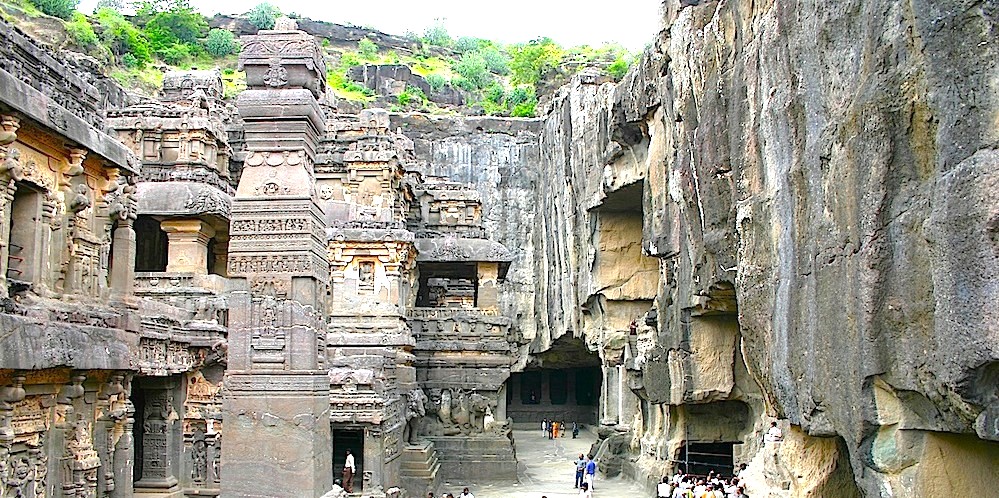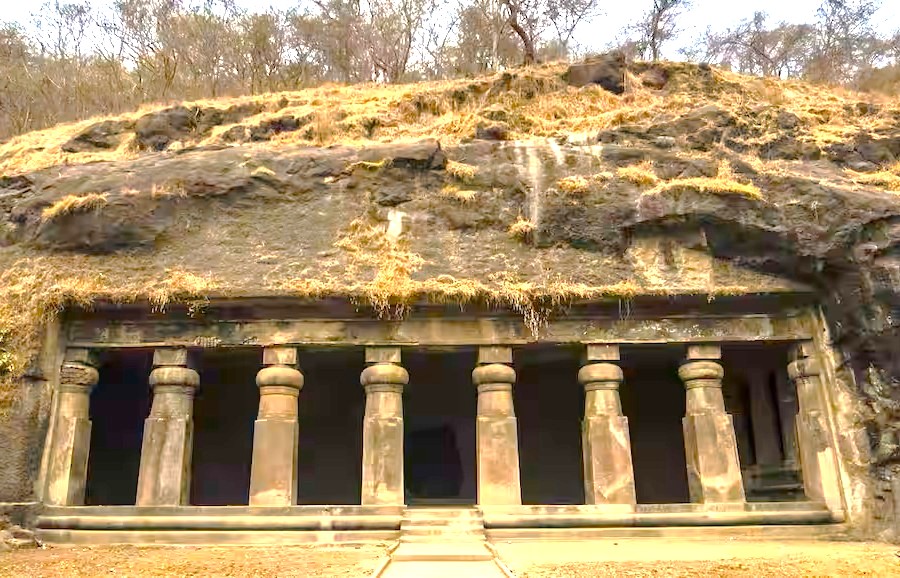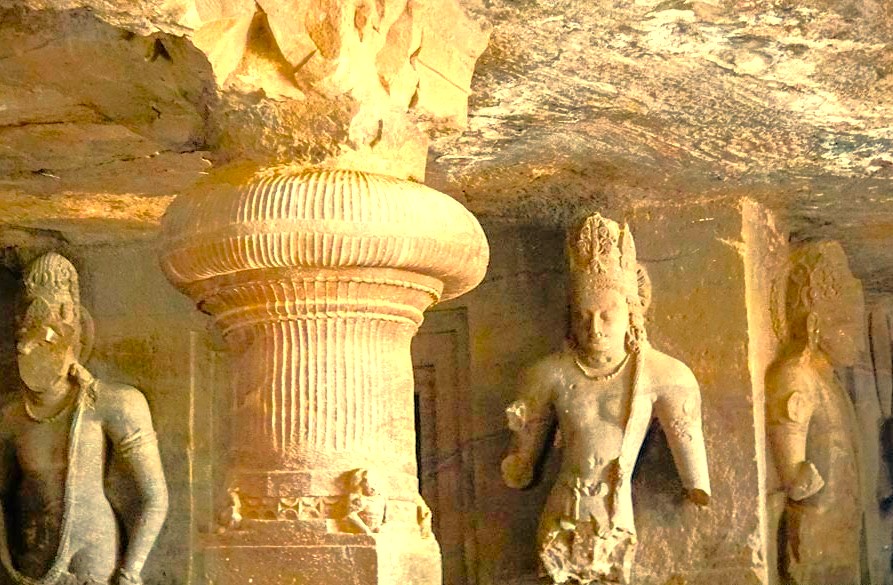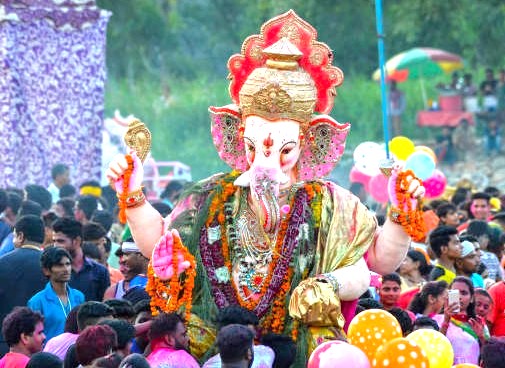Echoes of Ancient Lands
Elephanta Caves India Mumbai
Mother Masala Tours
Mumbai Unearthed
Elephanta Caves India Mumbai. The name "Elephanta" is derived from a large stone elephant that once stood near the island. This Unesco World Heritage Site is renowned for its stunning rock-cut sculptures, predominantly dedicated to the Hindu God Shiva, revealing the artistic heritage of ancient India. The history of theaves dates back to the 5th and 6th centuries AD, during the reign of the Maurya Dynasty. Initially known as Gharapuri - meaning "the town of caves", this site became a prominent pilgrimage destination. After the British arrived in the 19th century, they collected and restored these artifacts, which had been damaged over the years. The island's caves consist of two groups - Hindu and Buddhist - and the most famous of these is Cave 1, which features a colossal stone figure of Trimurti, depicting a three-headed Shiva.

Elephanta Caves India Mumbai: Sacred Spaces
To reach the island, we take a fun ferry ride from the famous Gateway of India. The journey lasts about 50 minutes, providing stunning views of the Mumbai skyline and the Arabian Sea. The ferry operates daily, and as we approach the island, the beautiful greenery and ancient sculptures beckon us to explore this truly fascinating historical site.
Timeless Artifacts

These caves are home to artifacts reflecting the region’s cultural and religious history across many centuries and dynasties. As we walk through the caves, we notice carved panels showing stories from Hindu mythology and many deities. We pause at Ganesha and Parvati figures, noticing balanced lines, detailed ornaments, and attentive expressions in stone craftsmanship. The centerpiece, Trimurti, stands around twenty feet tall, representing Shiva as creator, preserver, and destroyer in one sculpture. Each cave features distinct pillars, reliefs, and inscriptions.
Ancient Mosaics: Impeccable Craftsmanship
Elephanta Caves India Mumbai. The intricate craftsmanship found within the caves highlights the exceptional skills of ancient artisans. The rock-cut sculptures were created using the bas-relief technique, which involves chiseling away from a solid rock wall to produce detailed figures. The artistry dates back to the 5th century, attributed to the artisans who were part of the Maurya Dynasty. One of the most impressive features is the Sadashiva figure, located in the main cave, showcasing Shiva with three faces.
Displacement of the Stone Statue

A grand stone elephant, first noted by Portuguese explorers in the sixteenth century, once stood on Elephanta Island. Carved from basalt, the statue showed impressive scale and steady form across seasons, despite monsoon weather and neglect. To protect it from further deterioration, authorities arranged careful relocation during the mid nineteenth century to Victoria Gardens. Today, the site is known as Jijamata Udyan, where the elephant remains under attentive conservation practices. We walk shaded paths, read simple plaques and continue through gardens.
Capturing the Magic: A Photographic Haven
Here are exceptional opportunities for photography that capture their artistic and natural beauty. The stunning carvings inside the caves, especially the Trimurti and Sadashiva figures, create captivating focal points. The interplay of light and shadow presents a unique backdrop, inviting us to capture the intricate details of the sculptures. In addition to the artwork, we can also photograph the greenery around the caves, providing a stunning contrast to the ancient stone. The vibrant colors of the flora and the serene landscapes surrounding the island add to the immersive experience.
The Connection with the Gods

Primarily dedicated to Shiva, a central deity in Hindu tradition and stories. A modern display highlights Parvati, Shiva’s consort, presenting balance themes found across many temple narratives. We move through halls at an easy pace, reading simple signs that explain each featured element. Ganesha appears nearby, recognized for clearing obstacles, while Nandi stands steady as Shiva’s faithful bull companion. We notice carvings, shrines, and clean pathways, with staff guiding movement and answering practical questions when needed. Quiet corners and courtyards provide space to rest.
A Culinary Journey: Savor the Flavour
Elephanta Caves India Mumbai. Primarily known for their historical and cultural significance, the culinary offerings in nearby areas enhance the experience. One well-known dish available to savor is seafood curry, made with fresh fish caught from the Arabian Sea. The dish typically features a blend of spices, including turmeric, cumin, and coriander, creating a flavorful experience. As we try these local flavors, we not only enjoy delicious food but also engage with the culinary culture that reflects the lifestyle of the people living around the caves.
Festivals of Devotion: Honouring the Sacred and the Divine

The Caves serve as a focal point during the annual Ganesha Chaturthi festival, celebrated each August or September. This event honors Ganesha, recognized as the remover of obstacles and god of new beginnings. During the festivities, locals and many pilgrims gather at the caves. They engage in prayers and various rituals dedicated to the deity, creating a special atmosphere. Preparations for the festival often include the installation of large Ganesh idols. These impressive figures draw many crowds to the area, filling the space with activity. Devotees bring offerings of flowers, fresh fruits, and sweet treats to pay their respects.
Ancient Technologies: Sacred Sound, Geometry & Astrological Influences
Elephanta Caves India Mumbai. The caves, while primarily known for their stunning sculptures, also embody principles of ancient engineering and design. The rock-cut method of construction reflects advanced techniques, revealing how artisans worked with the natural rock to create enduring structures. Sacred geometry is subtly integrated into the layout of the caves. The design of the main cave, with its colonnades and open spaces, creates an atmosphere conducive to acoustic principles. Ancient texts refer to Solfeggio frequencies, particularly the 396 Hz frequency, which is believed to liberate negative energy and promote emotional healing. The arrangement of stones and carvings within the caves contributes to sound dynamics that resonate with these frequencies.
Resilience and Renewal: Overcoming Adversity’s Challenges

Elephanta Caves Mumbai tells stories of resilience through its long history. A significant challenge was the Portuguese invasion in the sixteenth century. This period led to the neglect of the caves, as focus shifted to fortifications and other colonial projects. The delicate carvings suffered from exposure and general damage. In the nineteenth century, British archaeologists recognized the immense historical importance of the site. They then began significant restoration efforts to preserve the ancient artworks. Sir Robert Gill documented the caves with detailed sketches and initiated preservation programs.
Urban Legends: Strange Sightings, Myths and Mysteries
The Island has its share of urban legends and intriguing stories that add an air of mystery surrounding the caves. One popular tale involves the Elephant Bull, believed to roam the island after dark. Locals speak of an unseen presence that is said to guard the caves, creating a sense of reverence among those who visit. Another myth recounts the lost treasure of Elephanta, rumored to be hidden within the caves by ancient kings. This tale has captured the imagination of adventurous souls throughout history, leading to quests for hidden riches.
Dive into the Legends, The Journey Starts Here - Join Us

Join us as we venture to Elephanta Island in Mumbai. This exploration offers ancient history, artistic brilliance, and cultural understanding. Stepping onto the ferry from the city's shore, we enjoy wide views of the Arabian Sea. Our journey takes us to this Unesco World Heritage Site. On the island, with each step through the caves, our guide shares local history and cultural insights. The guide provides simple facts about the stone carvings and the people who created them. We observe ancient structures, which stand as enduring testaments to past civilizations.